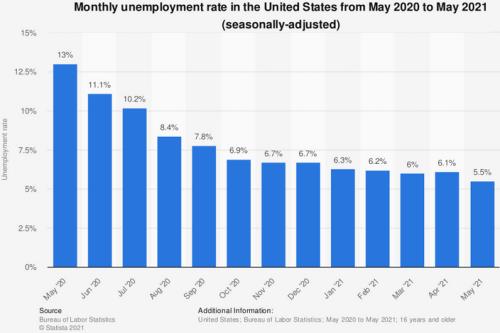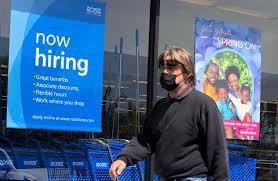 On Thursday June 3rd the Department of Labor reported initial jobless claims amounting to 385,000 for the week ending May 29th, lower than the previous week but below the consensus estimate of 400,000. This contrasts to the week of March 14th 2020 when 256,000 initial jobless claims were filed. With the advent of COVID the number spiked to three million during the following week and claims peaked at 6.1 million in early April 2020. Job creation during April 2021 was disappointing with only 266,000 new positions reported. Effective June 1st 2021, 15.4 million U.S. workers were receiving benefits, approximately half of the number recorded during mid-March 2020.
On Thursday June 3rd the Department of Labor reported initial jobless claims amounting to 385,000 for the week ending May 29th, lower than the previous week but below the consensus estimate of 400,000. This contrasts to the week of March 14th 2020 when 256,000 initial jobless claims were filed. With the advent of COVID the number spiked to three million during the following week and claims peaked at 6.1 million in early April 2020. Job creation during April 2021 was disappointing with only 266,000 new positions reported. Effective June 1st 2021, 15.4 million U.S. workers were receiving benefits, approximately half of the number recorded during mid-March 2020.
The Friday, June 4th data on job creation indicated that 559,000 new positions were created in May 2021 and that the unemployment rate fell to 5.8 percent. Although the U.S. economy has come a long way from the corresponding period in 2020, new job creation in May was lower than an expected value of 671,000. The current enigma is that employers in service industries including recreation, restaurants and health care are currently paying premiums and bonuses to recruit workers while unemployment remains at a disproportionately high level.
 Commentator Michael Smerconish in his Saturday, June 4th CNN program questioned whether the American work ethic is dying. Currently unemployment benefits with added Federal assistance of $300 amount to $618 per week. this represents slightly more than $15 per hour for a 40-hour work week. Accordingly, it is claimed that many workers have no incentive to return to their previous employment even if it exists. Acting on this presumption, sixteen states have decided to cut the $300 weekly benefit at the end of June in an attempt to restore the workforce. This change will impact close to 600,000 who are currently unemployed and drawing benefits. To date thirty-five states have imposed a requirement to actively seek work to receive unemployment benefits.
Commentator Michael Smerconish in his Saturday, June 4th CNN program questioned whether the American work ethic is dying. Currently unemployment benefits with added Federal assistance of $300 amount to $618 per week. this represents slightly more than $15 per hour for a 40-hour work week. Accordingly, it is claimed that many workers have no incentive to return to their previous employment even if it exists. Acting on this presumption, sixteen states have decided to cut the $300 weekly benefit at the end of June in an attempt to restore the workforce. This change will impact close to 600,000 who are currently unemployed and drawing benefits. To date thirty-five states have imposed a requirement to actively seek work to receive unemployment benefits.
There are in fact factors other than unemployment insurance payments that are contributing to the disinclination of workers to return to their previous or alternative positions. In many cases, closed schools present a problem of childcare with the burden falling heavily on women. There is still a fear of COVID especially in minority groups that have found difficulty in receiving a vaccine. In the absence of summer school programs and required remedial education that should be scheduled this summer, many workers will be unable to return to the workforce as a result of family obligations. Employers may well consider providing supplementary pay to compensate for childcare as an alternative to increasing wage rates. In the case of large plants and factories, on-site childcare may well be a future trend representing a tangible benefit for employees and engendering company loyalty. There may be many other benefits and in-kind inducements for workers including commuting allowances, providing van transport and predictable work schedules. Employers previously operating with a plentiful availability of workers have been reluctant to provide adequate sick, vacation and parental leave.
Prior to the advent of COVID there was considerable national debate over a $15 per hour minimum wage rate. The advent of COVID essentially rendered the question of raising the federal minimum wage moot given that the laws of supply and demand established realistic wage rates in diverse areas of the nation.
COVID clearly demonstrated an inequality among our workforce. College-educated white-collar workers were able in large measure to work from home and to keep their jobs. The trend towards work-from-home will probably intensify after relaxation of COVID restrictions.
Working from home allows for inexpensive childcare and home schooling to be integrated with job requirements. Studies have shown that employers actually benefit in terms of hours devoted to work through remote employment in addition to saving on office space and overhead. In contrast, after the advent of COVID, hourly-paid workers were either required to report to their place of employment or lose their jobs. Generally hourly-paid workers were concentrated in healthcare and other essential services including agriculture, hospitality, restaurants and the processing, distribution and sales of food.
In coming months, as our economy returns to pre-COVID levels, we will be faced with retraining redundant workers, providing new wage and benefit packages and modifying employment policies that encourage loyalty and commitment.